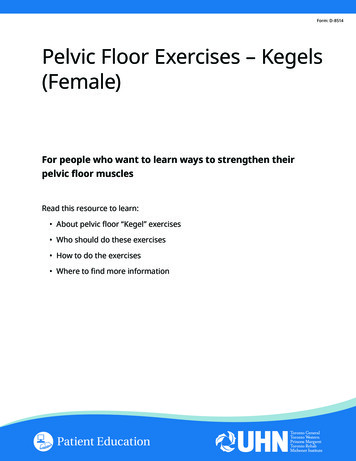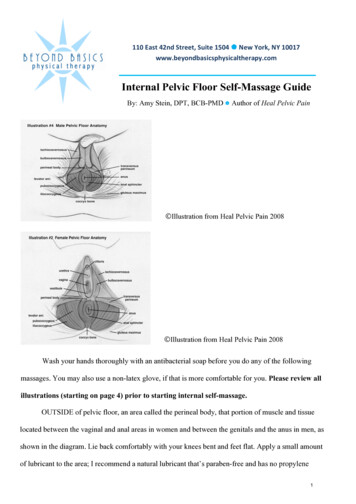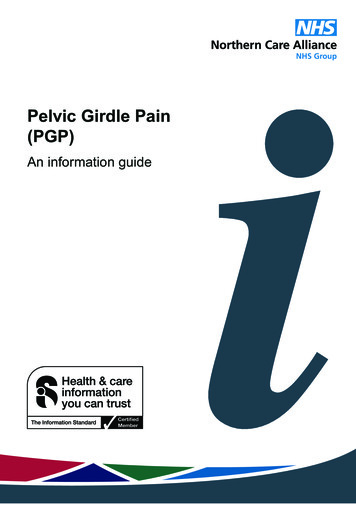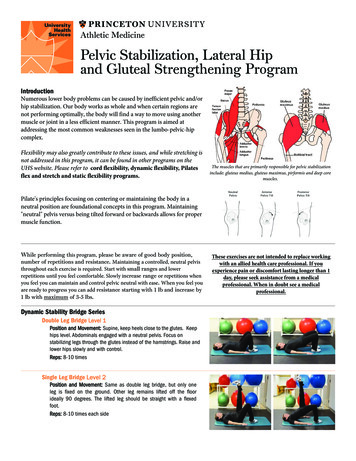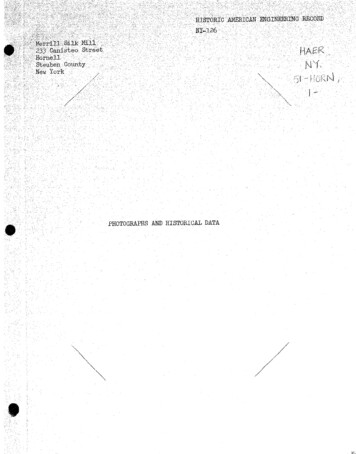
Transcription
Explaining How the Pelvic Floor Works and How to Activate andStrengthen Your Pelvic Floor MusclesTina Allen: So what isnormal for the bladder? Sowhat's normal? Which a lot of usmaybe never thought we werenormal or we didn't know whatwas normal. But what's commonout in the community forbladders that are problematic isin 24 hours, we go to thebathroom about five to eighttimes during the day. Okay. Thatmeans we go to the bathroomabout every two to four hoursand we arise at most one time anight to go to the bathroom. Sozero to one times in the middle of the night, we get up and go to the bathroom and then we normallydon't have to go to the bathroom just in case. Just in case.What we mean by that is, "I went out to dinner with my family and I got to the restaurant and I went tothe bathroom and we stayed in the restaurant for 45 minutes or an hour. And then I was like, Ooh, Ibetter go just in case, before the ride home." Or during any kind of movie or intermission, we're takingevery opportunity we can to go the bathroom. That's just in case, we shouldn't need to do that. So thatnormal bladder health is you can control when you go, as long as it's within reason and that's that twoto four hour window. We shouldn't need to push or strain in any way to go to the bathroom. We shouldbe able to sit down on the toilet and relax and then our bladder starts working.We shouldn't have to force it at all. We'll talk about some instances where you might do that and someoptions for that. But in general, it's a passive event. Just to realize there's always a little urine left in the
bladder after we go to the bathroom. If you've ever been to your doctor and you go to the bathroomand then they take a little scan of your bladder, what they're looking for is that you have less than 50milliliters of volume left in your bladder and that's considered normal. Some folks think that, that's like,"Why would there be something left?" Well, just to realize there's always a little blood left in your heartwhen it's pumping. There's always a little air left in your lungs when you're breathing. That's the samething with your bladder. You never empty your stomach fully. There's always a little something therestill. So, don't be concerned if there's a little there.Then usually when we go to the bathroom, we go a good amount. It's about 300 milliliters and for thoseof us who don't know the middle ear system very well, which is me, what we think of is that a tallStarbucks cup, and I know that we all don't go to Starbucks, but think about that tall coffee size that'sabout 300 milliliter. So when we go to the bathroom, that's a reasonable amount to go. If you're goingsignificantly less than that, you're probably going too frequently and if you're going significantly morethan that, you're likely delaying too much, which can be a problem also.Tina Allen: So there's thislittle sweet spot and this slidegives us an idea of that. Thenabout doing Kegels or doingpelvic floor muscle contractions.What we know, and thisresearch has been repeated,and I see it in my clinicalpractice all the time, which iswhat's most important to me iswhat I see clinically, which isthat if we just give somebody ahandout on how to do pelvicfloor muscle contractions, atleast 40% of them will not do itcorrectly. They'll do somethingelse. And for most of us it means we're bearing down. So we're pushing down which results in leakage.That doesn't mean don't try doing pelvic floor muscle contractions, but what it means is give it a try. Ifyou're not sure that you're doing it right or things don't improve, then you want some help and that'swhere you start looking for a pelvic rehab provider. Okay.This other part of this about talking about men, it's just this repeat that they went back and they lookedat this study again and then in 2013 and they found that using men, they were only able to do theexercises, the pelvic floor contraction in certain positions. That's not just men, it's true for women also,it just happened to be that this study was looking at men. We know that for women too, that differentpositions are easier to find your pelvic floor muscles. So that's a great place to start and then we'lladdress what you should do as you go forward in the next couple slides. So stay tuned.
So now, how do we do pelvic floor muscle contractions? We want to do more than squeeze. A lot ofpeople teach us to say lift and hold and squeeze. That's a great start. But what we know too is that thismuscle group has to work in varying ways. That means that it needs to squeeze in a little bit when yourbrain goes, "Oh, I'm going tosneeze." So it squeezes in alittle. And then when youactually sneeze, it squeezes ina little harder and thenthere's a little bit left in caseyou trip. While you'resneezing, you can squeeze ina little bit harder if all you dowhen you say, "Oh, I'm goingto sneeze." And you squeezeyour muscle as hard as youcan all at once when youactually sneeze. Or ifsomething else happens,while you're sneezing, you'remore likely to leak.Tina Allen: What we want to do is have you start learning to vary this contraction, and some of thatcan be that you think of an elevator and so you think of the doors closing as winking shut or graduallyshutting or shutting off the hose of the urethra. That's the closing of the doors. Then you go up eachfloor, so you squeeze in a little and then a little more and a little more. So close, lift, lift. You could thinkof it as holding back gas or stopping the urine flow and then pulling in a little harder. You could thinkabout closing the urethra and then pulling the genitals inward, lifting your pelvic floor muscles or thegenitalia from your underwear. So pulling inward. And then some of us just really have a hard timegetting to that zone and we just don't know where this area is of our body. So, if we sit here and I'mgoing to sit here right now, even though you can't see me and I'm sitting on my chair and I rock fromside to side, and I notice those two bones that are in my bum.So those are my sit bones, is what those are called, the bones that you sit on. You could think aboutdrawing those two sit bones together and lifting the perineum or the tissues in between those twobones off the chair. Here, I don't mean that to be overwhelming, but I want to give you some ideas ofthings you could try, to try to localize these muscles. The reason why we want to localize these musclesis we figured out how to use these muscles at a much earlier age and they just did their job and thensuddenly they stopped doing their jobs. So now you have to give them a little bit of attention to helpyou find those muscles and then help build them up so you're connected to them and then we carrythem over to function, which we'll talk about coming up. So just some things to think about.
Where people often cheat is they will hold their breath. If I held my breath right now, so I'm going tomake a noise like I'm holding mybreath. I sat there and I suddenlygrabbed my breath. To do that Ipushed my abdomen down. Wellmy bladder lives in that area thatI just pushed down. So when Ihold my breath, I'm increasingthe pressure on my bladder area,which could result in leakage.That's why we want you to holdyour breath, not hold yourbreath, "Oh goodness,goodness." We want you to nothold your breath while you'redoing your Kegels. Try to do anice gentle breathing with it. Wedon't want you to bulge yourabdomen or bear down like you're trying to have a bowel movement that could result in some leakage.If you cheat and use your thigh muscles or your glute muscles, they're kind of the big strong siblings whokeep compensating for the weaker pelvic floor muscles. If our big strong siblings keep taking over ourthighs and our glutes, then our pelvic floor never has a chance to catch up. So we really want to try toisolate those pelvic floor muscles before we start using other muscles with it. Then some people tend tocurl their toes or they tighten their upper chest as they're doing their Kegels and we want to. Initially,maybe that's what needs to happen, but then be aware of those and get rid of them as you get moreand more connected to your pelvic floor.Activating and Strengthening Your Pelvic Floor MusclesTina Allen: Then if you can't find your pelvic floor muscles, there are ways to activate them usingsome othermuscles. Thesetwo pictures showthat. So the firstpicture is this onehere, the one onthe left. Thegentleman issitting in a chairand he has a ballbetween his knees.You could use akid's ball or youcould use a throwpillow or you couldroll up a towel andplace that betweenyour knees and give it a gentle squeeze. When you give it a gentle squeeze, very gentle, maybe a pound
of pressure, it activates those muscles. Then you could try your Kegel. You could try that tightening.Close off the water, close off the hose and then relax. That act of squeezing together the knees ever sogently helps your brain find your pelvic floor muscles.Now this one over here, the one on the right, the gentleman has a band around his knees and placingthe band around his knees. This is an elastic band called TheraBand. Placing that around his knees andthen pressing out into it a little bit. So externally pressing outward. So if his hands were on the sides ofhis knees, he would press out into his hands very gently that one or two pounds of pressure again andperform. Once you've done that, activate your pelvic floor muscles. When we're not feeling our pelvicfloor muscles very well, this exercise, one of the two of these may be really helpful for you to localizethose muscles. So that's worth a try if it's hard to find the muscles.Now, once you found the muscles,it's great to do your contractionsin positions that you're reallycomfortable in such as sitting orlaying down. But here's the wrap.We don't tend to leak sitting orlaying down per se. Some of us do,but not all of us. When we leak, ison the way to the bathroom. I'veread all the things that say, "Oh,do Kegels at stoplights." Mychallenge to that is if you only docables at stoplights, you're onlydoing cables when you're sitting.Tina Allen: So my joke is if you onlydo Kegels at stoplights, you will only be continent when you're at stoplights. What I want to push you todo is actually do some Kegels once you feel like you've got it.Tina Allen: I want you to try doing Kegels when these pictures over here show when you're climbinga step, can you in this position that this person's in go ahead and try doing some Kegels. This personhere on the left is standing on one leg, she's very supported and let's have a wall behind her in case sheloses her balance. She could hold onto something, but can she do a Kegel with standing on one foot? Sothis is going to start mimicking what it's like to actually do a functional activity. And that's really whatwe're looking for because most of us leak when we're on the way to the bathroom, when we're goingfor a walk, when we cough, laugh or sneeze.I really think once you feel like, "Oh yeah, I've got this." Your next group of exercises that you do shouldbe in standing or standing in varied positions. Now, we've often read way back in the day that youshould do 300 cables a day. That is the elephant in the room, because that's what people were told.Well, guess what? You're not supposed to do 300 Kegels a day. You wouldn't do 300 bicep curls a day.You don't need to do 300 Kegels a day. Most of us need to do 20 to 30 but if we're rehabbing, if we'rehaving a lot of problems, maybe 40 a day at different sessions. So you break it up in different ways andyou do it throughout the day in varied positions. So the days of doing 300 Kegels a day should be over.
What that tends to do is fatigue our muscle so much and then we leak. So let's not fatigue our musclesso much that we leak. Let's strengthen it, so it has time to get stronger and more active.
of pressure, it activates those muscles. Then you could try your Kegel. You could try that tightening. Close off the water, close off the hose and then relax. That act of squeezing together the knees ever s

